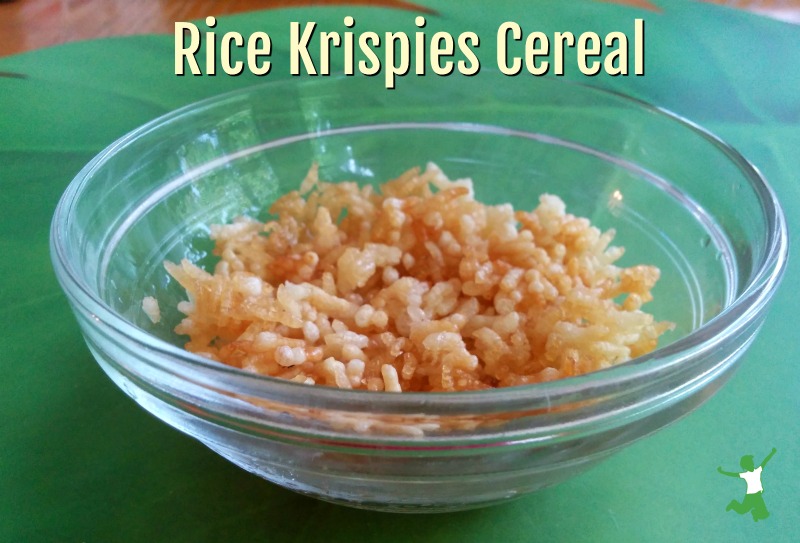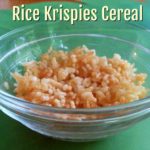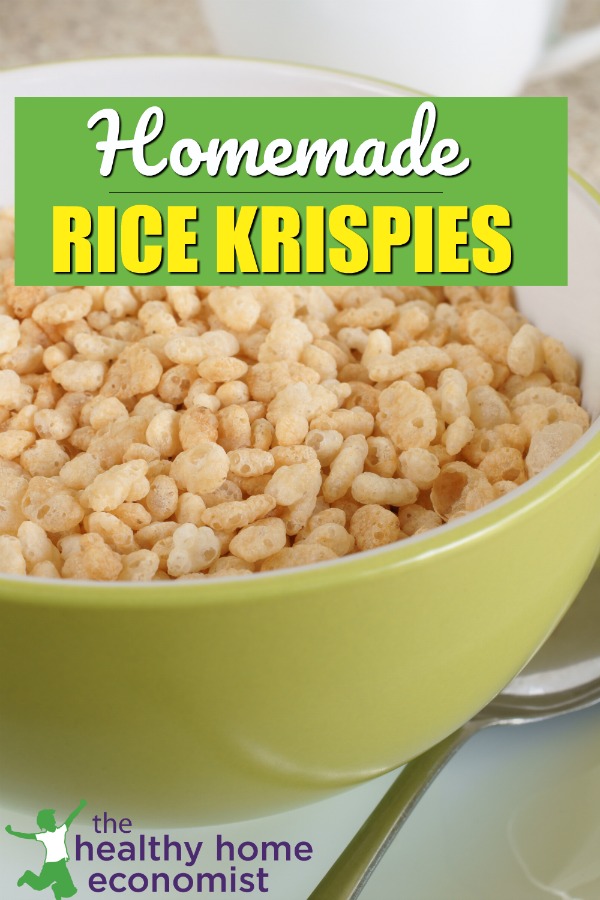Make homemade rice krispies cereal yourself with leftover cooked rice. A healthier option than artificially fortified, GMO cereals.

Eliminating processed foods from the pantry is a difficult road at first. Probably one of the hardest items to stop buying is the ubiquitous boxed breakfast cereal, without a doubt, America’s favorite way to start the day.
The problems with conventional boxed breakfast cereals like rice krispies are many. Genetically modified ingredients, loads of sugar, additives, and chemicals with plenty of synthetic vitamins added to the mix. This artificial fortification hides a multitude of dietary sins from the consumer examining the nutrition label.
The issue with organic boxed cereal is less clear. Examination of the ingredients for many brands seems harmless enough with just a few whole foods listed.
The apparently healthy label hides a nasty little secret, however. Violent factory processing is required to manufacture it.
Factory Processing Destroys Cereal Grain Proteins
This factory driven process, called extrusion, applies so much heat and pressure to the cereal grains that they actually liquefy. This slurry allows the grains to be quickly and easily shaped into the puffs, flakes, and other shapes that make each cereal distinct.
The manufacturing process used to make boxed cereal is so violent and denaturing that the proteins in the grains are actually rendered toxic and allergenic as a result. This is why whole grain boxed breakfast cereal is shockingly even more toxic than cheap boxed cereals made with white flour — because whole grains are higher in protein.
The more protein, the more toxic the boxed cereal.
What to do?
The good news is that unhealthy versions of processed foods like boxed breakfast cereal can usually be replicated at home using simple preparation techniques which do not denature the food or add toxins like what happens in a factory.
Puffing Rice at Home is Easy!
The recipe below provides an easy way to make rice krispies at home to enjoy as a cereal or to make rice krispies snack bars. The simple process involves blending rice and water, soaking overnight, cooking, and then drying/puffing on the stovetop.
By making your own homemade rice krispies, you can enjoy all the crisp yumminess without taking the risk of developing food allergies or digestive issues from factory-produced versions loaded with toxic grain proteins.
This recipe is best in small batches of 8 servings total. This ensures that you won’t overeat the cereal and it will be a treat to enjoy once or twice a week.
Bonus! If you love this recipe, try these homemade marshmallow krispie bars too!

Rice Krispies Cereal Recipe
Make homemade rice krispies cereal yourself with leftover cooked rice. It is a far healthier option than synthetically fortified, GMO-ridden boxed cereals.
Ingredients
- 2 cups white basmati rice
- 3 cups filtered water
- expeller pressed coconut oil
- 3 Tbl Plain, whole milk yogurt
Instructions
-
Combine rice and water in a pot. Note: It is best not to use wild rice or brown rice for this recipe.
-
Optional step to add extra digestibility to the rice: Stir in yogurt, buttermilk, lemon juice, whey or apple cider vinegar and leave covered on the counter for a minimum of 7 hours.
-
Bring pot to a boil. Cover with a tight fitting lid, reduce heat to a low simmer and cook for 10-15 minutes or until all the liquid is absorbed.
-
Remove pot from heat, crack the lid slightly and let cool.
-
Spread cooled, cooked rice on cookie sheets thinly so that the rice is no more than 1/4 inch thick.
-
Preheat oven to 275 F/135 C and dry the cooked rice for 2 hours.
-
Remove dried rice from the oven and let cool for 5 minutes.
-
Heat small pan filled with 1 inch of expeller pressed coconut oil to 375 F/190 C using a digital food thermometer. Take care not to heat the oil higher than this temperature or it will cause free radicals called acrylamides to form in the oil.
-
Break the dried rice into chunks and drop one or two into the frying oil and leave for about 30-45 seconds. You will hear a popping sound as the cooked rice pops like popcorn.
-
When very lightly browned which takes less than a minute, remove the crisped rice from the hot oil with a stainless steel slotted spoon and place on a large plate covered with a clean tea towel to soak up excess oil.
-
Repeat until all the dried rice has been crisped.
-
Once cooled, break the homemade rice krispies into individual grains and store in a large glass mason jar in the refrigerator or cool cellar.
-
Serve homemade rice krispies in a bowl with milk or cream and a whole natural sweetener like sucanat or coconut sugar (where to find). Top with fresh fruit if desired.
Recipe Notes
Jasmine rice may be substituted for basmati rice if desired. Do not use wild rice.
Buttermilk, lemon juice, or ACV may be substituted for the yogurt but the taste of the cereal may be affected slightly.
If you accidentally end up with burnt rice in the first steps, the linked article provides an easy solution.
The homemade rice krispies may also be used to make rice krispies bars for school lunches and snacks. Click here for a homemade marshmallow recipe.

More Homemade Cereals to Try
Love these homemade rice krispies? Here are more healthy versions of boxed store cereals along with healthy rice recipes.
- Wheat or spelt cold breakfast cereal recipes
- Grain free cold breakfast cereal recipes
- Homemade corn flakes cereal recipe
- Perfect yellow rice recipe
- Saffron rice recipe
- Rice cakes recipe
* Why I use white rice instead of brown. This article details how to avoid arsenic contamination in rice.








i know this is pretty stupid but is there a way to do this with microwave
Not that I am aware of. I think the microwave would explode them before they would dry. Microwaves dry from inside out rather than outside in for conventional heat.
I was very excited to try this recipe out, as I’m really on a mission to try and eliminate processed foods from my family’s diet. I followed the recipe to a t, but something went very wrong. My rice did puff, but went dark very fast. When I lowered the oil temperature slightly, it didn’t puff. I suspected that I dried the rice out too much and tried again with a new batch, but it was just tough and not very nice at all.
Could you please take some step by step photographs if you do this again? It will be such a great help.
I do find your articles and linked articles extremely interesting. Thanks so much!
Acrylamide actually forms over 250 and it doesn’t form in the oil that forms on the actual carb that gets browned. If you check out dr. Michael Greger you will find the coconut oil is severely bad for your health as it does have the ability to raise your cholesterol. oils in general are not healthy though because they disrupt the end of helium and cause heart disease.
you had me until you said to use coconut oil, I am confused because you talk like this is a health version, coconut oil, plan oil and palm kernel oils are all solids making them almost as bad for you as lard. They block your arteries and can cause strokes. I know coconuthad slot of healthy properties in them but the oil is bad. Would your recipe still work using a healthier oil such as olive oil, or do you need a solid to perform the task?
Coconut oil is perfectly healthy … cultures that consumed lots of it had no heart disease or strokes! The AHA has ignored this compelling anthropological data to smear a perfectly healthy fat. That said, if you don’t want to use it, use avocado oil instead. https://www.thehealthyhomeeconomist.com/avocado-oil/
thank you so much ma. I’m gonna try it out!
Thank you very much for the informative article. My family goes through great lengths to minimize exposure to processed foods, allergens and chemical toxins. We grow our own fruits and vegetables, and cook exclusively from scratch.
I would love to know more about the sources of your articles, so that I can share them with my admittedly sceptical neighbors and relatives. Can you share some published studies or journal articles I can pass along? I read the source article you cited regarding toxic protein development as well as the sources listed in that article. Your source article cites two unpublished studies done on rodents, who died as the result of ingesting processed grains. But these studies were non-scientific, performed in the 60s and 80s, and not peer reviewed, tested or related. The author draws the conclusion that toxic cereal grains are too blame for the rodent deaths, even though one study states that the rodents died from acute diabetic symptoms likely caused by the high refined sugar content in the cereals. As per the author, neither study did additional research to identify which toxins cause the deaths, or even verify that toxins were the cause. The other study is not cited at all.
I don’t disagree that processed foods are less safe for consumption, which is why I don’t feed my family processed foods, but I will have a tough time convincing naysayers without strong sources.
Can you please provide some reading material or resources I can cite? Published, peer reviewed studies would be best I guess.
FYI…I JUST SHARED YOUR CRISPY RICE RECIPE ON LINE BECAUSE WE ARE BOYCOTTING ALL OF KELLOGGS PRODUCT…SO KEEP MAKING THIS STUFF AND POSTING IT. WE DEPLORABLE’S WILL NOT BE HUMILIATED BY KELLOGGS AND FED CRAP ANYMORE!
So I tried this and all I got was really hard rice, not puffy and flaky. Hard and quite crunchy. Any suggestions?
There’s no way deep frying rice is healthier than toasting and popping moisurized rice kernels in the husk like they’re supposed to be puffed.
Hello,I know this may be a late comment but im using regular coconut oil and i do not have a thermometer, should i still be scared of free radicals? and is there real damage that the free radicals can do in this recipe? please reply 🙁